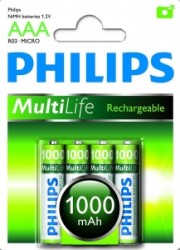Recall that

Therefore by rearranging the equation
Charge = Current•Time
In terms of units this is
Coulombs = A•s
 The number of Coulombs stored in a battery is equal to the Amps that can be drawn out of the battery times the length of time it takes to draw the Amps out. This gives the number of Coulomb's of charge stored in the battery. Battery manufacturers have given consumers a similar way to measure the amount of charge in a battery. On the package it lists the amount of charge in units called A•h or mAh. Recall that the "m" symbol is used to indicate milli units, x 10-3. These units are pronounced AmpHours or milliAmpHours. to the right is an image of a package of rechargable batteries. The storage capacity of each battery is prominantly displayed on the package. It is 1000 mAh which converts to 1 Ah. The number of Coulombs stored in a battery is equal to the Amps that can be drawn out of the battery times the length of time it takes to draw the Amps out. This gives the number of Coulomb's of charge stored in the battery. Battery manufacturers have given consumers a similar way to measure the amount of charge in a battery. On the package it lists the amount of charge in units called A•h or mAh. Recall that the "m" symbol is used to indicate milli units, x 10-3. These units are pronounced AmpHours or milliAmpHours. to the right is an image of a package of rechargable batteries. The storage capacity of each battery is prominantly displayed on the package. It is 1000 mAh which converts to 1 Ah.
| Example |
| A pack of batteries is labeled such that is says each battery has a charge of 2300 mAh. If these rechargeable batteries are used in the remote for a Wii video game controller that draws 0.23 Amps, then how much time will it take before the batteries go "dead?" |
Givens
Q = 2300 mAh = 2300x10-3 Ah = 2.3 Ah. You will need to convert the current units to the same scale. Either convert both to Amps or milliAmps. In this case the Amps was chosen.
I = 0.23 A
t = ?
Since the charge is now given in mAh, (milliAmpHours) the time will also have units of hours. |

Notice how the units of Amps divides out leaving the units of hours for time. |
|
Note: Adding batteries to a device by placing them in a row, end-to-end, does not increase battery life.

Adding batteries side does increase battery life. Nearly all appliances do not add batteries like this. Even though they look side by side, they are still connected end to end.

All of the battery charging questions will use I=Q/t. An easier way to solve these battery charging problems is by using dimensional analysis. This could have been done for the example problem by taking AmpHours and dividing it by Amps.

Refer to the notes for an example problem (Click here)
|